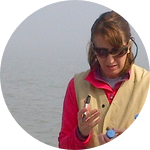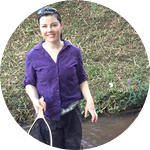About This Project
The success of invasive species is likely influenced by many environmental factors. Disturbances such as contaminants, sediment runoff, and loss of riparian habitat may make rivers more vulnerable to the impacts of invasive species. We are developing a project to determine the role of river degradation in facilitating the spread of an invasive fish species, the Round Goby, in the rivers and streams that flow into the Great Lakes.
Ask the Scientists
Join The DiscussionWhat is the context of this research?
The Round Goby was first discovered in the St. Clair River in 1990 and has readily spread throughout the Great Lakes region. Given the likelihood of further spread, and the uncertainty about their impact on native fishes, it is important to understand what makes Round Goby such a successful invader so control measures may be implemented to decrease range expansion and negative impacts in Great Lake tributaries. This project will specifically address the consequences incurred by native species exposed to the invasive Round Roby and utilize that information to develop management suggestions. By assisting management decisions, we will contribute to invasive species control and prevention.
What is the significance of this project?
This research represents an assessment of ecosystem health that is often overlooked when considering Great Lakes habitats. Tributaries are point source inputs for pollution, maintain water resources for a large proportion of the population in the Great Lakes, and serve as important habitat for various life history stages of aquatic organisms. My work will establish a greater understanding of how humans impact this part of the ecosystem, and will thus allow more effective management and conservation of aquatic resources. While a main goal of this project will be to develop a framework upon which managers and local agencies can make decisions to prevent further spread of Round Goby, I will also produce invaluable data on the current distribution and impacts of Round Goby in Michigan.
What are the goals of the project?
This project began in 2015 and will continue through 2017. Each year we have visited seven rivers which are tributaries to the Great Lakes. On each river, we fully sample the fish community at three sites. Some sites represent habitats where Round Goby have already invaded, while others have not yet been invaded. By comparing the condition and diet of native competitors between sites with and without Round Goby, we can infer the impact Round Goby have on native fishes. We also take a set of habitat and water quality measurements so we can understand how stream degradation may vary with this relationship. We suggest that in more degraded habitats, Round Goby will be more abundant, and the impact on native fishes will be stronger.
Budget
Although most of the lab and field work can be done at minimal costs, stable isotope samples have to be sent out to another institution to be analyzed. Each sample costs about $10 and we anticipate running six samples per site for each of the three years of our study.
Stable isotope analysis is a method often used in ecology to determine the relative composition of the ‘food web’. This is important when discussing the interactions between species because it can tell us whether one species is feeding ‘higher’ in the food web than the other (or potentially consuming the other species). In our case, we hope to determine whether there is any overlap in the food web of the invasive round goby with native fish species.
Endorsed by
Meet the Team
Corey Krabbenhoft
I received my B.S. in 2009 and M.S. in 2012, both from the University of New Mexico. My master’s thesis was on the role of young-of-year fish in arid river food webs. After a brief stint as a technician at Texas A&M University, I am now in the third year of my Ph.D. at Wayne State University in Detroit.
I initially became interested in the conservation of fishes while completing my undergraduate degree. Studying aquatic organisms in the desert, conservation is a natural part of the discussion. While many interests are at stake when thinking about conserving water resources, it is easy to forget that humans are not the only ones who rely on sources of freshwater.
When I moved to the Great Lakes area to pursue my Ph.D., I found the focus of conservation was quite different, but the underlying principles are the same - conservation of native biotas benefits ecosystem health in addition to municipal and recreational interests. In this part of the country, invasive species are one of the largest threats to freshwater ecosystems. The Great Lakes now have over 180 introduced species. With the overall goal of conservation of native biotas in mind, I hope to contribute, at least in some small way, to better management of invasive species.
Lab Notes
Nothing posted yet.
Project Backers
- 5Backers
- 18%Funded
- $350Total Donations
- $70.00Average Donation

